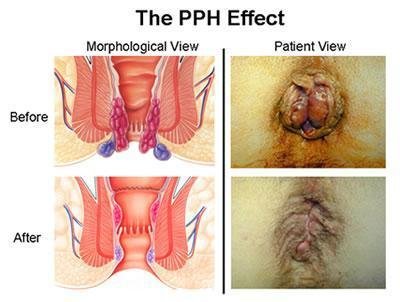Hemorrhoids
Hemorrhoids are swollen (dilated) veins located in or around the anus and rectum.Hemorrhoids are very common, especially during pregnancy and after childbirth. They result from increased pressure in the veins of the anus. The pressure causes the veins to bulge and expand, making them painful, particularly when you are sitting.The most common cause is straining during bowel movements. Hemorrhoids may result from constipation, sitting for long periods of time and anal infections. In some cases they may be caused by other diseases, such as liver cirrhosis.Internal hemorrhoids occur just inside the anus at the beginning of the rectum. External hemorrhoids occur at the anal opening and may protrude outside the anus.Symptoms of hemorrhoids include anal itching, anal pain, bright red blood on toilet tissue, pain during bowel movements or a hard tender lump near the anus.Hemorrhoids can be diagnosed by rectal examination and anoscopy (lighted tube inserted into the anus).
Hemorrhoid Banding
Hemorrhoid banding is well tolerated and is performed in our office. Sometimes local anesthesia is required. For hemorrhoid banding, the first step is to insert an anoscope, a tube like instrument with a light, to peer into the anus and expose the hemorrhoids. The hemorrhoids are then held by an instrument while it places one or two tiny rubber bands around the base of each internal hemorrhoid. This cuts off circulation to the hemorrhoid, causing it to fall off. The band will fall off in about one to two weeks after that. A scar will form where the hemorrhoid was, which serves to maintain the veins in place so they do not protrude into the anal canal.It is recommended that only one or two hemorrhoids be taken care of at one sitting. While some people prefer to have all of them banded at one time, it should be noted that this usually causes extreme pain and it is better to treat a couple hemorrhoids at a time every four to six weeks.Expect some bleeding when the hemorrhoid falls off and for up to fourteen days after the procedure.For a few days, you may have difficulty controlling the passage of gas and bowel movements. When you return home after the procedure, take sitz baths as recommended. Sitz baths will help relieve discomfort and clean the area.For a sitz bath, sit in warm water for 10-15 minutes. Pat the area dry. Do not wipe or rub vigorously. You may be advised to take a sitz bath every four hours and after every bowel movement. Devices are available to place on top of a toilet to make this process easier. Move your bowels as soon as you feel the urge. Do not strain during a bowel movement.To prevent constipation and straining, use a stool softener, drink plenty of fluids and eat plenty of high fiber foods.
Hemorrhoidectomy/PPH ( Procedure for Prolapse and Hemorrhoids)
A hemorrhoidectomy is an operation to remove hemorrhoids. Hemorrhoidectomy is used to treat painful, swollen hemorrhoids when they do not get better with other therapies. Severe bleeding, severe pain, thrombosed hemorrhoids and prolapsed hemorrhoids are some indications for surgery.PPH or Stapled Hemorrhoidecotmy employs a unique circular staplet which reduces the decree of prolapse by excising a circumferential strip of mucosa (inner lining) from the anal canal. This has the effect of interrupting the venous drainage in this region which corrects problems with bleeding in the region.This procedure is performed under general anesthesia. The procedure usually takes 20-30 minutes. Most patients can be treated as an outpatient and go home the same day as their procedure.
THD (Transanal Hemorrhoidal Dearterilization)
This new technique (THD) uses a Doppler ultrasound probe to pinpoint the actual branches of the hemorrhoidal arteries. An absorbable suture is then used to “tie-off” or ligate the arterial blood flow. This technique does not remove any tissue, instead a “lift” is performed called a Hemorrhoidopexy. This restores the protruding tissue back to its correct anatamical position. Because there is no tissue being removed, the post-operative pain is significantly reduced and the recovery and return to daily activities is quicker.







